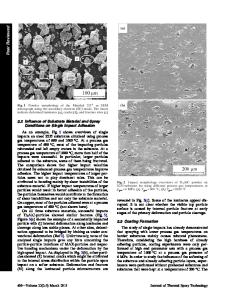Synthesize of V 4 AlC 3 Based MAX Phase Composites by Reactive Spark Plasma Sintering of V 2 O 5 :Al:C
- PDF / 5,083,187 Bytes
- 11 Pages / 595.276 x 790.866 pts Page_size
- 87 Downloads / 316 Views
Synthesize of V4AlC3 Based MAX Phase Composites by Reactive Spark Plasma Sintering of V2O5:Al:C Leila Sadeghi1 · Mansour Razavi1 · Mohammad Mahdi Kalantarian1 · Mohammad Reza Rahimipour1 · Mohsen Hossein‑Zadeh2 Received: 15 June 2020 / Accepted: 6 August 2020 © The Korean Institute of Metals and Materials 2020
Abstract In this research V 4AlC3 based composites were synthesized by reactive spark plasma sintering (RSPS) method. V 2O5:Al:C starting materials with molar ratios of 1:6:1.5 and 1:7:1.5 were heat treated at 1400 °C. Final composition, microstructural, physical, mechanical and tribological properties of the prepared composites were compared. The X-ray diffraction analysis results showed that the formation of V4AlC3 as main phase alongside Al2O3 and V2AlC by-products. Increasing the Al content from 6 moles to 7 moles led to formation of V C0.845 and Al2O3 main phases as well as V 4AlC3 and V2AlC minor phases in this sample due to extraction of Al from die during RSPS operation. Microstructural studies revealed that the uniform distribution of the phases with low amount of porosities. The layered microstructure of the composites confirmed the formation of MAX phases. Higher bending strength and is achieved for the synthesized composite prepared by 7 moles Al (490 ± 5 MPa) than the composite prepared with 6 moles Al (375 ± 11 MPa). The composite prepared with 7 moles Al also exhibited lower wear rate (3.7 × 10− 5 mm3/Nm) than that of prepared with 6 moles Al (2.4 × 10− 4 mm3/Nm). Microstructural studies of the worn surfaces indicated that tribo oxidation is dominant mechanism for both fabricated composites. Keywords V4AlC3 · Composite · MAX phase · Mechanical properties · Wear
1 Introduction In recent years, much attention has been paid to the synthesis, characterization and application of MAX phases due to their amazing properties [1, 2]. These materials with layered structure have a combination of properties of metals and ceramics including electrical and thermal conductivity, thermal shock resistance, machinability, high elastic properties, high strength and in some cases high creep resistance and high temperature oxidation resistance [2]. MAX phases have a general formula of Mn + 1AXn (n = 1, 2 and 3) where M is transition metal, A is A-group element (mostly IIIA and IVA groups) and X is either N or C element [3, 4]. Accordingly, more than 60 MAX compositions with formulas of 3AX2 (312 type) and M 4AX3 (413 type) M2AX (211 type) M * Mansour Razavi m‑[email protected] 1
Department of Ceramic, Materials and Energy Research Center, Tehran 3177983634, Iran
Materials and Metallurgical Engineering Department, Semnan University, Semnan 3513119111, Iran
2
have been discovered so far [5]. For the first time, 211 and 312 types of MAX phases were discovered by Jeitschko and Nowotny as H phases [6–8]. After 3 decades, 413 type of MAX phases were discovered by Barsoum et al. [9]. The V-Al-C system was first studied by Schuster et al. [10]. In this study the V 2 AlC phase was disc
Data Loading...











